"Roma" by Alfonso Cuarón |
Read more at in70mm.com The 70mm Newsletter |
| Written by: Text and images by Netflix | Date: 18.09.2019 |
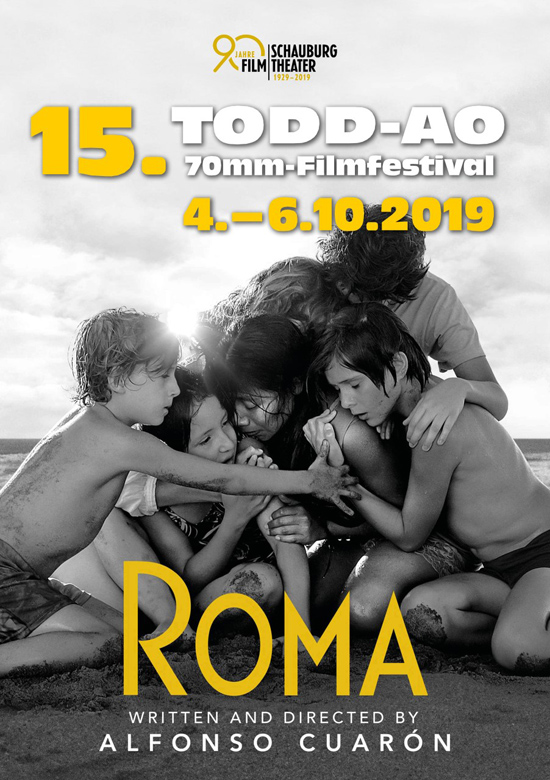 The most personal project to date from Academy Award®-winning
director and writer Alfonso Cuarón, Roma follows Cleo (Yalitza
Aparicio), a young domestic worker for a family in Mexico City’s middleclass
Roma neighborhood. Delivering an artful love letter to the women
who raised him, Cuarón draws on his own childhood to create a vivid and
emotional portrait of domestic strife and social hierarchy amidst Mexico’s
political turmoil of the 1970s. Roma marks Cuarón’s first project since
the groundbreaking Gravity in 2013. Roma premiered at the Venice
Film Festival where it was awarded the Golden Lion. After receiving the
Golden Lion at the Venice Film Festival, the film received a rapturous
response from festival audiences around the globe. Produced by
Esperanto Filmoj and Participant Media, Roma will launch globally on
Netflix as well as theatrically around the world in December. The most personal project to date from Academy Award®-winning
director and writer Alfonso Cuarón, Roma follows Cleo (Yalitza
Aparicio), a young domestic worker for a family in Mexico City’s middleclass
Roma neighborhood. Delivering an artful love letter to the women
who raised him, Cuarón draws on his own childhood to create a vivid and
emotional portrait of domestic strife and social hierarchy amidst Mexico’s
political turmoil of the 1970s. Roma marks Cuarón’s first project since
the groundbreaking Gravity in 2013. Roma premiered at the Venice
Film Festival where it was awarded the Golden Lion. After receiving the
Golden Lion at the Venice Film Festival, the film received a rapturous
response from festival audiences around the globe. Produced by
Esperanto Filmoj and Participant Media, Roma will launch globally on
Netflix as well as theatrically around the world in December."Roma" is presented in 70mm at the 15th Todd-AO Festival, Schauburg Cinerama, Karlsruhe, Germany • 15. Todd-AO 70mm-Festival 2019 • Destination Film: Roma in 70mm • 70mm Blow Up List 2018 - by in70mm.com Original titel: Roma (2:15) Filmed in: Digital media. Principal photography in: Alexa 65. Presented on: The curved screen in 7OMM with 6-track DATASAT stereo. Aspect ratio: 2,21:1. Country of origin: Mexico. Production year: 2018 World Premiere: 30 August 2018 (Venice Film Festival). German premiere: 06.12.2018. The most personal project to date from Academy Award®-winning director and writer Alfonso Cuarón, Roma follows Cleo (Yalitza Aparicio), a young domestic worker for a family in Mexico City’s middleclass Roma neighborhood. Delivering an artful love letter to the women who raised him, Cuarón draws on his own childhood to create a vivid and emotional portrait of domestic strife and social hierarchy amidst Mexico’s political turmoil of the 1970s. Academy Awards, 2018 • Best Foreign Language Film of the Year - Mexico • Best Achievement in Directing - Alfonso Cuarón • Best Achievement in Cinematography - Alfonso Cuarón Academy Awards Nominee, 2018 Best Motion Picture of the Year - Gabriela Rodriguez, Alfonso Cuarón Best Performance by an Actress in a Leading Role - Yalitza Aparicio Best Performance by an Actress in a Supporting Role - Marina de Tavira Best Original Screenplay - Alfonso Cuarón Best Achievement in Production Design - Eugenio Caballero, Barbara Enriquez Best Achievement in Sound Editing - Sergio Diaz, Skip Lievsay Best Achievement in Sound Mixing - Skip Lievsay, Craig Henighanm, José Antonio García |
More in 70mm reading: Destination Film: Roma in 70mm 15. Todd-AO 70mm-Festival 2019 Internet link: |
About the Production |
|
|
For the past three decades, the films of
Academy Award®-winning
director Alfonso Cuarón have transported audiences to unfamiliar
worlds, including a Victorian girl’s school, an infertile dystopian future,
Harry Potter’s enchanted world and the vast emptiness of outer space.
In his latest project, Roma, Cuarón returns to the Mexico City of his
childhood, where a family struggling to remain whole finds strength from
an unexpected source. The filmmaker began thinking about making a movie based on memories
of his childhood home and the neighborhood around it more than 15
years ago. After the overwhelming worldwide success of Gravity, Cuarón
decided it was time to move forward with his passion project. “While I
was finishing my previous film, I promised myself that my next would
be something simpler and more personal,” he recalls. “I realized that it
was finally the moment in which I could go back and do a film in Mexico,
but with all the resources, tools and techniques I’ve acquired over the
years.” With a shooting schedule that spanned 108 days, his longest ever, Cuarón was truly able to focus on the details of what he and his family could recall of this moment in time. According to David Linde, CEO of Participant Media, “I love the way he goes from an epic film like Gravity to very intimate dramatic stories,” he says. “He’s one of the few directors who can make expansive stories that are just as intimate and dramatic as smaller films. Everything he does has an element of the personal.”
The casting team interviewed thousands of people and Cuarón chose a smaller number whom he asked to talk about themselves in brief oncamera interviews. The filmmaker team was very thoughtful about the process because it was so particular, in part, because of the need for their resemblance to be almost exact to the actual people they were portraying. “We did a huge search for all of the main characters who are based on people he has known for more than 50 years,” says producer Gabriela Rodriguez, “It was a very important part of the storytelling process that we needed to get exactly right.” Cleo is played by Yalitza Aparicio, a young woman with no acting experience who was discovered by the film’s dedicated casting director in a rural village in the Mexican state of Oaxaca. “Our whole casting team went from little village to little village. That’s how we found Yalitza. I asked Yalitza who her real best friend is and she introduced us to Nancy García, who in turn plays her best friend Adela in the movie,” says Cuarón. Coming to Mexico City for the film was only her second visit to the capital.“Yalitza is not a professional actress but she is the most amazing actress I’ve ever worked with,” says Cuarón. “In some ways she was being Yalitza, but she was also conveying something different. She learned how to assume her role in the smallest details and gestures. Without Yalitza, this film would fall apart.” The cast members never saw a complete script of the film (nor did the
crew, only Cuarón had the entire script throughout shooting). Each
character knew his or her own story, as well as the group’s history.
The film was shot in chronological order — which is very unusual for a
feature —and Cuarón talked each of them through what was going on in
each scene. “Sometimes I would just tell them what we were doing. For
specific dialogue, I would give it to them in the morning, so they could
learn it and have a sense of what was happening. The whole idea was to
disrupt the notion of a pre-rehearsed scene.”
Cuarón assembled an exclusively Mexican crew who could contribute their
own knowledge and memories to the film. “I really needed people who
understood what I was talking about because I wanted everybody to be a
resource, either in terms of research of the period or their own memories.” |
|
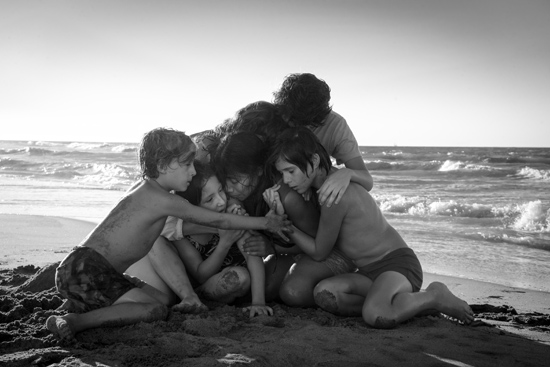 Production designer Eugenio Caballero, the Oscar® winner behind the
stunning imagery of Guillermo del Toro’s Pan’s Labyrinth, was brought in
to recreate the Roma of Cuarón’s past. “To work with Alfonso on a project
about Mexico and in some ways about my childhood was extremely
exciting,” he says, “Most of the scenes were shot where the actual events
occurred, but we had to transform virtually every location we used.” Production designer Eugenio Caballero, the Oscar® winner behind the
stunning imagery of Guillermo del Toro’s Pan’s Labyrinth, was brought in
to recreate the Roma of Cuarón’s past. “To work with Alfonso on a project
about Mexico and in some ways about my childhood was extremely
exciting,” he says, “Most of the scenes were shot where the actual events
occurred, but we had to transform virtually every location we used.”For the main location where most of the film takes place, Caballero literally built a near exact replica of Cuarón’s childhood home. He constructed a set within an actual house that had the historical feeling they were looking for. “Our main set is the family’s home,” he says, “We wanted not only to recreate the time, but also to reflect their personalities by including particular things that Alfonso and I remembered.” The production company reinforced the structure, tore down existing walls and installed moveable walls. In the home’s courtyard, an elaborate system of rails and drapes could manipulate the light to resemble day or night, rain or shine. “We had amazing flexibility to stage scenes without interruption as the actors went from room to room,” says Cuarón. To dress the set accurately, Cuarón contacted his family members to retrieve whatever furniture and personal items from the house were still in existence. He also relied on old family photos and what they could all recall from memory. “The rooms are full of our stuff,” he says. “There’s an old chair that was in my grandmother’s house. The dining room, the breakfast room, and the living room have a lot of the original furniture. There is a portrait that’s supposed to be Sofia and is actually my mother. Many of the objects in the children’s rooms are things we kept or reproduced for the film. Even Borras the dog is identical to my childhood dog, right down to the name.” Viewing the completed set for the first time was unexpectedly emotional, recalls the director. “I did not anticipate the impact it would have on me and my family. They came to visit the set and had the same reaction I did. We had not only re-created the interior of the house, but we changed the façade and parked exactly the same cars on the street outside. It was home.” According to Caballero, re-creating the economic and social contrasts of 1970s Mexico City was perhaps the most satisfying part of this job. “On the one hand, there is Insurgentes Avenue, which was the most elegant, upscale part of the city at that time,” says the production designer. “There is the middle-class neighborhood of Roma. And then we see the beginning of Netzahualcóyotl, a sprawling slum that was just starting to develop in those years. It’s like a lost city in the sense that they didn’t have any infrastructure.” The reenactment of the student demonstration and the Corpus Christi Massacre was staged at the massive intersection of Mexico-Tacuba where the actual events took place, which is now a constantly busy part of the city. Hundreds of cars, extras and stunt performers were brought in to reenact the notorious tragedy. “We had to build the furniture store, from where the action is seen, and totally transform the street to match the historic references,” says Caballero. “It’s a very well-documented event that we could rebuild on the very place that it happened.” |
|
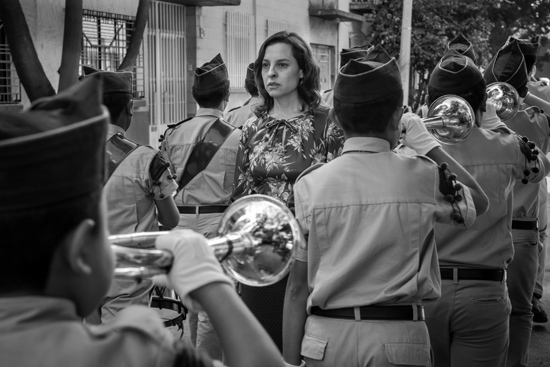 That was the film’s most difficult location, says producer Nicolás
Celis. “We took over one of Mexico City’s main avenues, as well as the
surrounding streets, and that took months of work,” he explains. Shooting
the scene as authentically as possible wasn’t simple: bicycle lanes were
removed, the street was repainted to remove the lines now dividing the
lanes; poles were removed and neighbors’ water tanks were covered. “A
lot of work had to be done over several months so that the street would
look like it did in 1971.” That was the film’s most difficult location, says producer Nicolás
Celis. “We took over one of Mexico City’s main avenues, as well as the
surrounding streets, and that took months of work,” he explains. Shooting
the scene as authentically as possible wasn’t simple: bicycle lanes were
removed, the street was repainted to remove the lines now dividing the
lanes; poles were removed and neighbors’ water tanks were covered. “A
lot of work had to be done over several months so that the street would
look like it did in 1971.”Costume Designer Anna Terrazas also had to go back in time to find and create period clothing that would stand out in a black in white film, which requires finding the right textures and designs. “Alfonso was very involved in the fittings we did for the key cast and even the hundreds of extras to make sure we had the period right and as he remembered it,” said Terrazas. She also relied on Cuarón’s old family photos to recreate exact replicas of the family’s wardrobe to dress the cast. Cuarón and his sound team created Roma’s dense audio tracks using Dolby Atmos, which allows sounds to be precisely placed and moved in three-dimensional space. He first used the system on Gravity, which won Oscars® for both sound mixing and sound editing. “Atmos was in diapers back then, but I was so impressed,” he says. “I wanted to see what Atmos would do in an intimate film. With visuals, you see foreground, midground and background. We wanted the sound to have the same kind of layering.” Sound can be every bit as evocative as visual images, and each street in Mexico City has its own unique soundtrack, according to Cuarón. “That’s something I wanted to honor. Different street vendors call attention to themselves by shouting, or with whistles or flutes or bells. Each car in traffic sounds different. The sounds have to move from one place to the other when the camera is moving. When we finished the mix, we sent the files to Dolby and they told us that there had to be a mistake. These files were six times bigger than any others that they had ever received. It was not a mistake ― it was just the amount of detail that we put into it.” Cuarón also worked with music supervisor Lynn Fainchtein to select source music reflective of what was heard in Mexico City during the years the story takes place. The soundtrack includes songs by Mexican singers, English-language rock bands of the era — popular with young middle-class Mexicans at the time — and even Mexican covers of English-language classics, such as Mexican rock pioneer Javier Batiz’s interpretation of “House of the Rising Sun,” heard during Cleo’s visit to the impoverished shantytown where her ex-boyfriend is living. |
|
About the Cast |
|
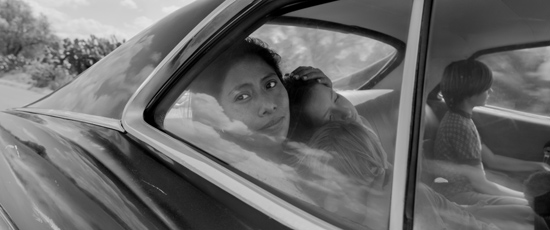 YALITZA
APARICIO (CLEO) Yalitza was born in Tlaxiaco, Oaxaca in
1993. She holds a degree in education and aspires to become a teacher
upon completion of her exams but also has additional opportunities
ahead of her since the film has been completed. YALITZA
APARICIO (CLEO) Yalitza was born in Tlaxiaco, Oaxaca in
1993. She holds a degree in education and aspires to become a teacher
upon completion of her exams but also has additional opportunities
ahead of her since the film has been completed.Yalitza went to her local community center to accompany her sister to the casting call and ended up trying out and being selected. She is very close with another actress from Roma, Nancy García, who lives in a nearby town in Oaxaca. Yalitza also developed strong relationships with the child actors that formed her family on set. Yalitza took advantage of working in Mexico City and visited Chapultepec Park and the pyramids of Teotihuacán. She loved being on set and seeing how spaces were transformed. She also enjoyed working with Cuarón and building the relationship of trust they came to share. MARINA DE TAVI RA (SOFIA) is a Mexican theatre, film, and television actress. Her career has mainly developed on the Mexican stage working with the most prestigious directors in the scene. She has played the lead parts in stagings of playwrights like Bertold Brecht, Harold Pinter, David Mamet, and Ximena Escalante. In film she has worked with directors like Rodrigo Plá (in the film winner of the Lion of the Future Award in Venice 2007), Carlos Carrera, Issa López, Mariana Chenillo, Hari Sama and Alfonso Cuarón in his most recent film Roma. Her most recent TV work includes the series “Ingobernable” for Netflix, and “Falco” for Amazon directed by Ernesto Contreras. Her work has been nominated and awarded by various theatre critics and journalist associations in Mexico. NANCY GARCÍA (ADELA) was born in 1994 in the small Mexican town of Santa María Yucuhiti, Tlaxiaco, Oaxaca and currently lives in Guadalupe Miramar, a community embedded in the Mixteca Oaxaqueña. Passionate about sports, she is a leader in a female athletic movement, advocating for women to have more opportunities in this area. She also dreams of opening a pastry shop. García learned about the casting for Roma because of Yalitza Aparicio, one of her best friends, who invited her to the community center in Tlaxiaco so she could help with a translation in the Mixteco language. Upon arriving, García was interviewed and then asked to perform a scene. Aparicio, who was already in Mexico City, gave her the assurance she needed to travel to the capital for the second phase of casting where she got the role. Nancy thoroughly enjoyed her experience on set, working alongside Yalitza and with director Cuarón as well as the cast and crew. |
|
About the Filmmakers |
|
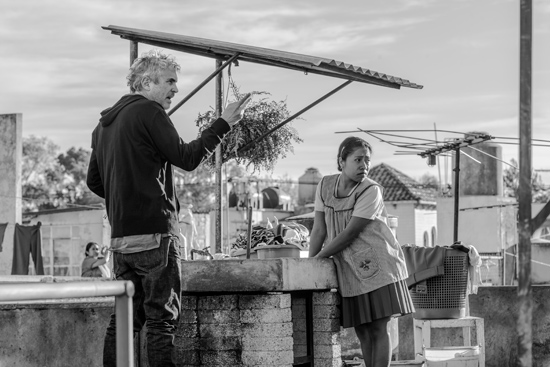 ALFONSO
CUARÓN (DIRECTOR, WRITER, PRODUCER,
DIRECTOR OF PHOTOGRAPHY, EDITOR) is a two-time Academy
Award® winner who has written and directed a wide range of acclaimed
films. He most recently won two Oscars® for directing and editing the scifidrama Gravity, which he also co-wrote with his son Jonás. Cuarón also
produced the highly praised box-office hit, which starred Sandra Bullock
and George Clooney. ALFONSO
CUARÓN (DIRECTOR, WRITER, PRODUCER,
DIRECTOR OF PHOTOGRAPHY, EDITOR) is a two-time Academy
Award® winner who has written and directed a wide range of acclaimed
films. He most recently won two Oscars® for directing and editing the scifidrama Gravity, which he also co-wrote with his son Jonás. Cuarón also
produced the highly praised box-office hit, which starred Sandra Bullock
and George Clooney.Cuarón made his feature film directorial debut with Sólo con Tu Pareja (Love in the Time of Hysteria), a dark comedy starring Daniel Giménez Cacho and Claudia Ramírez. The film, 1992’s biggest box-office hit in Mexico, earned Cuarón an Ariel Award as co-writer. He made his American feature film debut with A Little Princess, a critically acclaimed 1995 adaptation of the beloved children’s book. The film was nominated for two Academy Awards® (Best Cinematography and Best Art Direction) and Cuarón won the Los Angeles Film Critics Association New Generation Award. This success was followed in 1998 by Great Expectations, a contemporary adaptation of Charles Dickens’ classic novel that starred Gwyneth Paltrow, Robert De Niro, Anne Bancroft, and Ethan Hawke. With his next feature, Cuarón returned to Mexico to direct a Spanish-speaking cast in the funny, provocative, and controversial road comedy Y Tu Mamá También, for which he and his brother Carlos Cuarón shared an Academy Award® nomination for Best Original Screenplay. The film also received BAFTA nominations for Best Film Not in the English Language and Best Original Screenplay. In 2004, the director helmed Harry Potter and the Prisoner of Azkaban, the third installment in the most successful motion picture franchise of all time. Cuarón’s next project, Children of Men, was one of the most talked-about films of 2006. The dystopian drama, which he edited and co-wrote with Timothy Sexton, earned Oscar® nominations for editing, screenplay, and cinematography. Cuarón also produced Desierto, co-written and directed by his son Jonás Cuarón and starring Gael Garcia Bernal and Jeffrey Dean Morgan. He executive produced the documentary This Changes Everything, directed by Avi Lewis, which explores the impact of economic models on climate change. |
|
 EUGENIO
CABALLERO (PRODUCTION DESIGNER) was the Academy
Award®-winning designer of Guillermo del Toro’s modern classic Pan’s
Labyrinth. Caballero’s work on the film also earned him a host of awards
including those of the Art Directors Guild (the most prestigious honor
in his field), the Ariel, Los Angeles Film Critics Association, and the Gold
Derby, in addition to BAFTA, Goya, and Satellite nominations. In total, he
has been nominated seven times for the Ariel, Mexico’s top film award,
also winning for Carlos Salcés’ Zurdo. EUGENIO
CABALLERO (PRODUCTION DESIGNER) was the Academy
Award®-winning designer of Guillermo del Toro’s modern classic Pan’s
Labyrinth. Caballero’s work on the film also earned him a host of awards
including those of the Art Directors Guild (the most prestigious honor
in his field), the Ariel, Los Angeles Film Critics Association, and the Gold
Derby, in addition to BAFTA, Goya, and Satellite nominations. In total, he
has been nominated seven times for the Ariel, Mexico’s top film award,
also winning for Carlos Salcés’ Zurdo.Caballero’s credits include nearly 30 films, with 20 as production designer. He has worked with directors such as Jim Jarmusch (The Limits of Control), Baz Luhrmann (Romeo + Juliet), Sebastián Cordero (Cronicas, Rage and Europa Report), Floria Sigismondi (The Runaways), Claudia Llosa (Aloft), Fernando Eimbcke (Club Sandwich), Carlos Cuarón (Rudo y Cursi), and Russell Mulcahy (Resident Evil: Extinction), among others. Born in Mexico City, Caballero began his career in Mexico after studying the history of art and cinema in Florence, Italy. After getting his start on award-winning music videos and short films, he quickly transitioned to feature films as an assistant designer and set decorator. Caballero’s collaboration with J.A. Bayona on The Impossible starring Naomi Watts, Ewan McGregor, and Tom Holland earned him Goya and Art Directors Guild nominations in 2013. In 2015 and 2016, he worked with the director again on A Monster Calls, based on the award-winning book by Patrick Ness, which earned Caballero a third Goya Award nomination. The production designer’s work was also honored with Gaudí, Fenix and Platino awards. In 2014, Caballero designed the Paralympic Opening Ceremony of the Sochi Winter Olympics for director Daniele Finzi. He collaborated with Finzi again on the new Cirque du Soleil show “Luzia” in 2016. Caballero has served as a jury member at numerous international festivals. He is a member of AMPAS (Academy of Motion Picture Arts and Sciences) as well as the Mexican and Spanish film academies. GABRIELA RODRÍGUEZ (PRODUCER) has more than 14 years of filmmaking experience, having worked on a diverse slate of projects marked by a rich collaboration with acclaimed director Alfonso Cuarón. She is currently running Cuarón’s film production company, Esperanto Filmoj, in London. In recent years, Rodríguez produced the short film Aningaaq directed by Alfonso’s son Jonás Cuarón. Hailing from Caracas, Venezuela, Rodríguez began her career as an intern at Alfonso Cuarón’s office in New York City. She was later promoted to assist Cuarón in 2006, playing a pivotal role in the production of the Academy Award®-nominated sci-fi drama Children of Men. Rodríguez subsequently served as associate producer on Cuarón’s Academy Award®-winning box-office hit Gravity, starring George Clooney and Sandra Bullock. NICOLÁS CELIS (PRODUCER) is a Mexican producer and the founder of Pimienta Films, whose work includes such highly original and impactful projects as Ciro Guerra’s Birds of Passage, which was selected to open the Directors’ Fortnight at Cannes 2018, and Jonás Cuarón’s Desierto, which won the FIPRESCI prize at the Toronto International Film Festival. Pimienta Films was named one of the three best production houses in Mexico by Variety, and The Hollywood Reporter named Celis a talent to watch in 2017. He is currently developing Tatiana Huezo’s Night of Fire. Previously, Celis produced the drama-horror feature film We Are What We Are, which competed for the Camera d’Or at the Cannes Film Festival as well as Watching It Rain, a short film by Elisa Miller, which won the Palme d’Or for best short film at Cannes. Celis’ other credits include Rafi Pitts’ Soy Nero, Tatiana Huezo’s feature documentary Tempestad, and Amat Escalante’s The Untamed, which won the prize for best direction at the Venice Film Festival. Celis supports future generations of producers by hosting workshops and master classes in academic and cultural settings, both in Mexico and abroad. He has also participated in meetings and workshops such as ACE Mundus, EAVE Puentes, Producers Network, and TorinoFilmLab, among others. DAVID LINDE (EXECUTIVE PRODUCER) is chief executive officer of Participant Media, the global media company founded in 2004 by Jeff Skoll, which is dedicated to entertainment that inspires and compels social change. Linde is responsible for leading the company’s overall strategy, day-to-day operations, content creation, advocacy, strategic investments, and acquisitions. As an industry content leader, Participant annually produces up to six narrative feature films, five documentary films, three episodic television series and more than 40 hours of digital short form programming through its digital subsidiary SoulPancake. Participant’s content and social impact mandate speaks directly to the rise of today’s “conscious consumer,” representing over 2 billion consumers who are compelled to make impactful content a priority focus. Through its worldwide network of traditional and digital distribution aligned with partnerships with key non-profit and NGO organizations, Participant is positioned uniquely within the industry to engage a rapidly growing audience while bringing global awareness and action to today’s most vital issues. Noteworthy films from Participant include Oscar® Best Picture winner Spotlight; Academy Award® winner for Best Documentary Feature An Inconvenient Truth, A Fantastic Woman, which was honored with the Academy Award® for Best Foreign Language Film, as well as Lincoln, The Help, Wonder, RBG, The Look of Silence, CITIZENFOUR, and Food, Inc. In total, Participant has released more than 80 films, which collectively have earned 56 Academy Award® nominations and 12 wins. Linde’s background spans production, global distribution, and building multiple companies from the ground up. Linde most recently led Lava Bear Films, a production and financing company he founded with the support of Reliance Entertainment. While there, he produced the Best Picture Academy Award® nominated Arrival from director Denis Villeneuve. Prior to Lava Bear, Linde served as chairman of Universal Pictures where he successfully championed a broad outlook regarding international productions, animation and family entertainment, and distribution. Linde also served on the NBC Universal board of directors and as the chair of NBC Universal’s Diversity Council. Prior to his Universal appointment, Linde ran acclaimed specialty film studio Focus Features and its genre division, Rogue Pictures, both of which were formed from Universal’s acquisition of the acclaimed independent production company Good Machine, of which he was a partner. During his tenure at Focus, Co-Presidents Linde and James Schamus oversaw a diverse slate that was honored with an historic 53 Oscar® nominations and 11 Academy Awards®. Before Good Machine, Linde served on the senior leadership team at Miramax Films and was the founding executive of Miramax Films International. Linde currently serves on the Board of Governors of the Academy of Motion Picture Arts and Sciences, sits on the Board of Directors of Film Independent, and is on the Board of Trustees of New Roads School. Linde has been recognized for numerous awards, including The Will Rogers Motion Picture Pioneer of the Year, General Electric’s Chairman Award for Performance Turnaround, the Anti-Defamation League’s Distinguished Entertainment Industry Award, the New York Magazine: Best of the Industry Award, the Gotham Award for Distinguished Achievement, and the Locarno Film Festival’s Premio Raimondo Rezzonico Award. Linde and Cuaron have worked together on 7 films, including Roma, Children Of Men, and Y Tu Mamá También. |
|
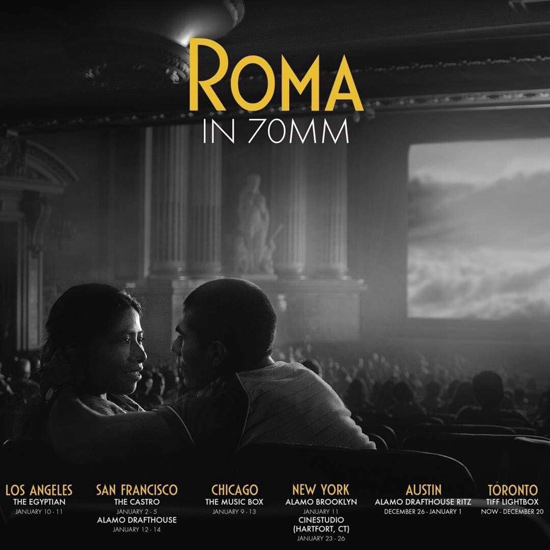 JEFF SKOLL (EXECUTIVE PRODUCER) is an entrepreneur devoted
to creating a sustainable world of peace and prosperity. Over the course
of nearly two decades, Skoll has created an innovative portfolio of
philanthropic and commercial enterprises, each a distinctive catalyst for
changing the issues that most affect the survival and thriving of humanity
– including climate change. This portfolio includes the Skoll Foundation,
Participant Media, Skoll Global Threats Fund, Capricorn Investment Group,
and new ventures – all coordinated under the Jeff Skoll Group umbrella. JEFF SKOLL (EXECUTIVE PRODUCER) is an entrepreneur devoted
to creating a sustainable world of peace and prosperity. Over the course
of nearly two decades, Skoll has created an innovative portfolio of
philanthropic and commercial enterprises, each a distinctive catalyst for
changing the issues that most affect the survival and thriving of humanity
– including climate change. This portfolio includes the Skoll Foundation,
Participant Media, Skoll Global Threats Fund, Capricorn Investment Group,
and new ventures – all coordinated under the Jeff Skoll Group umbrella.Skoll’s entrepreneurial approach is unique: driving large-scale, permanent social impact by investing in a range of efforts that integrate powerful stories, data, capital markets, technology, partnerships, and organized learning networks. Operating independently from one another yet deeply connected through shared mission, Skoll’s organizations galvanize public will, policy, and mobilize critical resources that accelerate the pace and depth of change. Inspired by the belief that a story well told can change the world, Jeff founded Participant Media in 2004. Participant Media is the world’s leading entertainment company focused on social impact. Participant has produced more than 80 feature-length narrative and documentary films. These films collectively have garnered 56 Academy Award® nominations and 12 wins, including Best Picture for Spotlight. Companion campaigns run by Participant have shaped consumer’s beliefs and actions, and in some cases have been instrumental in changing national and international policies working hand-in-hand with non-profit partners. As the first full time employee and President of eBay, Skoll experienced firsthand the power of combining entrepreneurship, technology, and trust in people. His work today embodies those critical lessons learned from eBay. All of Skoll’s organizations rely on the premise that people are basically good, and that if good people are given the opportunity to do the right thing, they will. JONATHAN KING (EXECUTIVE PRODUCER) is President of Narrative Film & Television for Participant Media, where he oversees the development and production of Participant’s narrative feature films and television projects. The company’s upcoming slate of films includes On the Basis of Sex, from director Mimi Leder and starring Felicity Jones and Armie Hammer; Green Book, starring Viggo Mortensen and Mahershala Ali and directed by Peter Farrelly; Rupert Wyatt’s Captive State; and The Boy Who Harnessed the Wind, adapted by and starring Chiwetel Ejiofor in his directorial debut. Participant’s first scripted limited series “Central Park Five,” created and directed by Ava DuVernay, will be produced in partnership with Tribeca Films and premiere on Netflix in 2019. Since joining Participant in 2007, King has overseen a robust slate of almost 50 films, including the 2016 Academy Award® Best Picture winner Spotlight, last year’s sleeper hit Wonder, Beasts of No Nation, The Help, Contagion, The Best Exotic Marigold Hotel, Deepwater Horizon, and Shot Caller. In 2012, he launched Participant’s Spanish language production initiative with Pablo Larrain’s No, which premiered at Cannes and was nominated for an Academy Award®. Since then, Participant’s Latin American slate has featured Larrain’s Neruda, Sebastian Lelio’s 2018 Academy Award® winner A Fantastic Woman, and Alfonso Cuarón’s eagerly awaited return to Mexico with Roma. Prior to joining Participant, King worked as both a producer and an executive for companies including Focus Features, Laurence Mark Productions, and Miramax Films. He started his film career in MGM’s New York office, scouting books, theater, and independent films. King currently serves on the board of advisors for the Outfest Legacy Project, 20 a partnership with the UCLA Film and Television Archive that restores and preserves important works of queer cinema. He also serves on the Dean’s Advisory Council of the Florida State University Film School, and on the board of directors of the John Alexander Project, a nonprofit dedicated to nurturing and supporting innovative investigative journalism. |
|
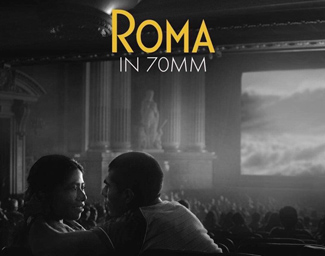 • Go to "Roma" by Alfonso Cuarón. Production Notes |
|
| Go: back - top - back issues - news index Updated 22-01-25 |

 Set
in 1970 and 1971 in the then down-at-its-heels Colonia Roma
neighborhood, the film would be a portrait of his family, his community
and of Mexico during a pivotal political moment in the country’s history.
Like the family depicted in Roma, Mexico itself was undergoing a
shattering transformation. A series of student demonstrations aimed at
promoting democracy climaxed in the infamous Corpus Christi Massacre,
when a government-supported paramilitary group known as Los
Halcones (the Hawks) brutally killed almost 120 people.
Set
in 1970 and 1971 in the then down-at-its-heels Colonia Roma
neighborhood, the film would be a portrait of his family, his community
and of Mexico during a pivotal political moment in the country’s history.
Like the family depicted in Roma, Mexico itself was undergoing a
shattering transformation. A series of student demonstrations aimed at
promoting democracy climaxed in the infamous Corpus Christi Massacre,
when a government-supported paramilitary group known as Los
Halcones (the Hawks) brutally killed almost 120 people.